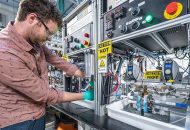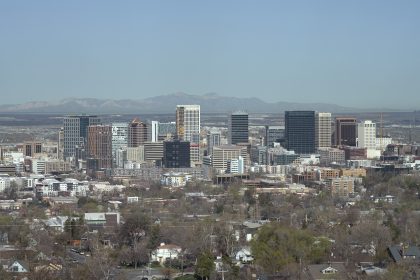CRISPR, GMOs, and the Future of Farming
COMMENTARY | The Ecomodernist

One of the biggest challenges facing agriculture in the U.S. and around the world is how to make farming more efficient and limit greenhouse gas emissions in the process. Among the most promising tools for doing so are CRISPR and GMOs.
Scientists are now using CRISPR gene editing — a new technology that took off in 2015 — to develop crops and livestock that allow farmers to produce more food on less land, reduce application of herbicides and pesticides, and reduce fertilizer runoff that pollutes water bodies.
Similarly, genetically modified organisms or GMOs — products of an older biotechnology that has been around since the 90s — have achieved significant success since their emergence and continue to play an essential role in reducing the environmental impacts of farming.
But in order for CRISPR gene editing and GMOs to reach their full potential to improve the environmental impact of farming, both biotechnologies must be better supported by regulations, funding and technology access. GMO technology in particular has not been well supported over the past 30 years. If problematic regulations persist, it could mean higher food prices and carbon emissions from food production.
CRISPR gene editing and GMOs are both biotechnologies used to make genetic changes to organisms. GMOs contain added “foreign DNA,” often from a different species, that gives them a new trait, while gene-edited organisms do not contain foreign DNA. Rather, gene editing — whether using CRISPR or older biotechnologies (like TALENs) — allows scientists to introduce precisely targeted changes into an organism’s existing DNA, either removing or amplifying a targeted trait.
Over the last 30 years, the biggest contributions of GMOs to agricultural sustainability have been herbicide-tolerant crops and insect-resistant crops. Herbicide-tolerant crops allow farmers to use less-toxic herbicides, better control weeds with less tillage and therefore grow more food with fewer greenhouse gas emissions. Pest-resistant crops both decrease pesticide use and better protect food production from loss due to pest damage.
Though existing GMOs are already widely adopted by farmers, there is still a lot of potential to develop more and different genetically modified, or GM, crops. In particular, GMOs can better address some problems that CRISPR gene editing can’t. For example, overapplication of fertilizer (either synthetic or manure) can result in excess nutrients running off agricultural soil and polluting water bodies, which is the main cause of the Gulf of Mexico dead zone.
Crops can be gene edited to use nitrogen from fertilizer more efficiently, which could help reduce this runoff; but genetic modification is necessary to give crops the ability to make their own nitrogen fertilizer through relationships with microbes in the soil (which some plants like legumes already do), which could dramatically reduce fertilizer application even more.
Genetic modification is also better suited than gene editing to improve photosynthesis, and improved photosynthesis can help increase crop yields, which can reduce the amount of farmland needed to meet food demand and thereby GHG emissions.
So far, two agricultural applications of gene editing have been commercialized, with many more in development. One gene-edited crop was commercialized in the U.S. in 2019: a soybean oil with higher levels of purportedly heart-healthy oleic acid, which was made using an older gene-editing technology, TALENs, rather than CRISPR. The first commercialized CRISPR gene-edited crop entered the market in Japan in 2021: a tomato with high levels of a purportedly healthy compound called GABA. Though both of these plants were gene-edited with traits that appeal to consumers, many others with traits that improve agricultural sustainability are in the development process.
For example, since climate change is increasing the frequency and intensity of drought and heat waves, crops like maize, soybean, and tomato have been gene edited to increase their tolerance to heat and drought, meaning they can produce more food under these increasingly challenging conditions.
There are also crops like wheat, for which GM varieties have not been commercialized, even though they could help reduce pest losses and increase yields. GM wheat varieties have likely not been commercialized in the US because many countries restrict the import of GM crops for human consumption — less of a problem for maize and soybean, which are mainly used for animal feed, as well as highly refined products for human consumption (which contain little to no remaining genetic material). Compared to GMOs, regulatory barriers for gene-edited crops are much lower in many countries, so gene-edited wheat varieties may have a better chance at commercialization than GM wheat.
Past regulations have stifled the potential for GMOs to improve agricultural sustainability, and current regulations threaten to do the same for GMOs, CRISPR, and future biotechnology. Between 2008 and 2012, meeting regulatory requirements to commercialize a GMO took an average of $35 million and 7 years. These high costs contributed to large corporations dominating the agricultural GMO market, which limited the number and the variety of products developed and weakened consumer trust.
Overall, federal regulation of GMOs and CRISPR gene-edited crops and livestock should be overhauled to be more accurately based on how much of a risk the products pose. Despite USDA’s recent update to regulation of GM and gene-edited crops — the SECURE rule — regulations are still based on comparisons to conventional breeding, which is an unscientific approach not easily adaptable to future technologies that will incur unnecessary costs.
Federal regulation of GM and gene-edited livestock by the FDA is even more restrictive. Only two GM animals have ever been approved in the U.S.: the AquAdvantage salmon, approved in 2015 after a 20-year wait, and the GalSafe pig, approved in 2020. USDA proposed new regulations for GM and gene-edited livestock in 2020, which was an improvement but didn’t go far enough, and has yet to be finalized; if finalized as-is it would likely accelerate the approval process for GM and gene-edited livestock.
To address these problems, the U.S. should pioneer the first true product-based regulation of agricultural biotechnology, which would efficiently allocate federal resources to the highest-risk products, keeping costs down and supporting innovation, and better adapt to future new biotechnologies, giving the U.S. an innovation advantage.
In addition to regulatory changes, improvements in technology access, transparency, and funding are crucial for maximizing the potential of CRISPR technology. First, CRISPR technology is variously covered by more than 6,000 patents in the U.S. alone, meaning that developers often must license multiple patents to commercialize just one product. The difficulty and cost of accessing CRISPR patents will inhibit innovation unless patent holders sign sharing agreements, consolidate their patents and provide transparent and affordable pricing for developers of different sizes.
Second, there is currently no requirement for companies to disclose products that are gene edited but exempt from USDA’s biotechnology regulations; nevertheless, they should do so in order to earn consumer trust through transparency.
Third, the development of CRISPR technology in the U.S. was itself a result of federal funding from the National Institutes of Health and increased federal research funding could further support fundamental research that improves agricultural biotechnology, leading to more efficient and productive farming.
The 2023 farm bill will be an opportunity to influence research funding for programs like the Agricultural Genome to Phenome Initiative, which was authorized in the 2018 Farm Bill. Looking ahead, we need to support these transformative technologies that can improve agricultural efficiency, while simultaneously reducing climate emissions. Both radical changes in regulation of agricultural biotechnology and strong leadership from Congress in the Farm Bill are crucial for realizing this potential.
Dr. Emma Kovak is a Sr. Food & Agriculture analyst at the Breakthrough Institute, a climate, energy, and agriculture research center based in Berkeley, California.






















